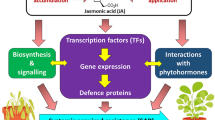Abstract
Incompatible combinations of plant and plant bacteria produce an incompatible reaction at different rates, producing, besides the typical hypersensitive reaction, also darkening, yellowing, and fading. Plants differ in their responsiveness to plant bacteria in terms of reaction rate. Study of incompatible reactions may differentiate the species and strains of plant bacteria if properly explored.
Similar content being viewed by others
References
Goodman R. N.:In vitro andin vivo interactions between components of mixed bacterial cultures isolated from apple buds.Phytopathol. 55, 217 (1965).
Goodman R. N.: The protection of apple tissue againstErwinia amylovora infection by avirulent strains and three other bacterial species.Phytopathol. 57, 22 (1967).
Goodman R. N., Plurad S. B.: Ultrastructural changes in tobacco undergoing the hypersensitive reaction caused by plant pathogenic bacteria.Physiol. Plant Pathol. 1, 11 (1971).
Klement Z.: Pathogenicity factors in regard to relationships of phytopathogenic bacteria.Phytopathol. 58, 1218 (1968).
Klement Z.: Development of hypersensitive reaction induced by plant pathogenic bacteria. Proc. 3rd Internat. Conf. Plant Pathogenic Bacteria (Wageningen 1971), p. 157 (1972).
Plement Z., Farkas G. L., Lovrekovich L.: Hypersensitive reaction induced by phytopathogenic bacteria in the tobacco leaf.Phytopathol. 54, 474 (1964).
Klement Z., Goodman R. N.: The role of Civing bacterial cell and induction time in the hypersensitive reaction of tobacco plant.Phytopathol. 57, 322 (1967a).
Klement Z., Goodman R. N.: The hypersensitive reaction to infection by bacterial plant pathogens.Ann. Rev. Phytopathol. 5, 17 (1967b).
Lovrekovich L., Farkas G. L.: Induced protection against wild fire disease in tobacco leaves treated with heat killed bacteria.Nature 205, 823 (1965).
Muller K. O.: Hypersensitivity, Vol. 1, p. 469 inJ. G. Horsfall, A. E. Dimond (Eds):Plant Pathology. Academic Press, New York-London 1959.
Solymosy F.: Biochemical aspects of hypersensitivity to virus infection in plants.Acta phytopathol. Acad. Sci. Hung. 5, 55 (1970).
Sule S., Klement Z.: Effect of high temperature and the age of bacteria on the hypersensitive reaction of tobacco toPseudomonas phaseolicola.Acta phytopathol. Acad. Sci. Hung. 6, 119 (1971).
Thiers H. D., Lester M. B.: Histological studies of bacterial blight infection of cotton plants.Phytopathol. 39, 479 (1949).
Ward H. M.: On the relations between host and parasite in Bromes and their brown rusts,Puccinia dispersa (Erikss).Ann. Botany (London) 16, 233 (1902).
Author information
Authors and Affiliations
Rights and permissions
About this article
Cite this article
Mukherjee, N., Sen Gupta, S. Incompatible reactions between some plants and pathogenic bacteria. Folia Microbiol 23, 394–398 (1978). https://doi.org/10.1007/BF02876442
Received:
Issue Date:
DOI: https://doi.org/10.1007/BF02876442




